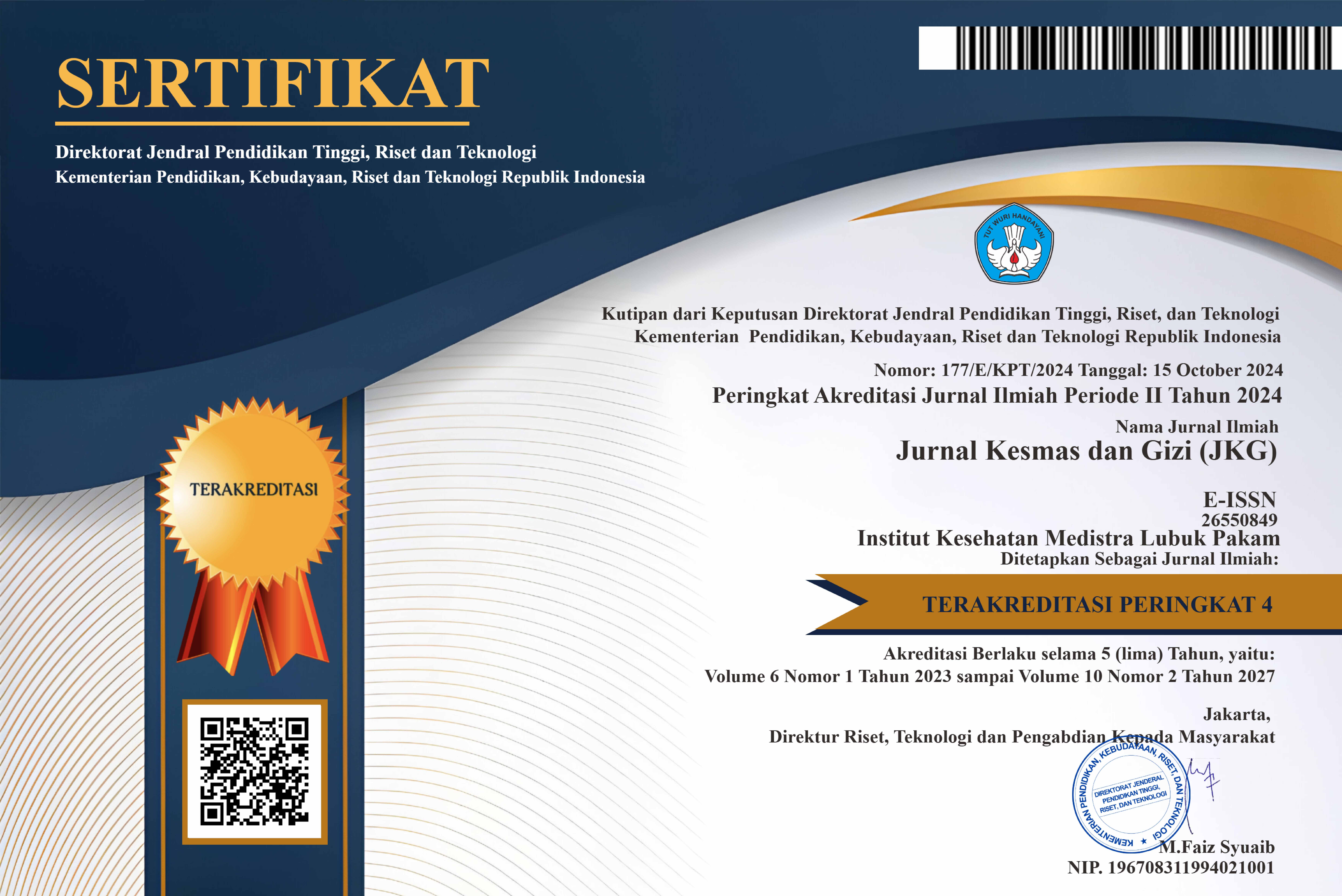The Correlation Between Protein Intake And Muscle Mass in Breast Cancer Patients at Dr. H. Abdul Moeloek Regional Hospital
DOI:
https://doi.org/10.35451/jkg.v6i2.2048Keywords:
Protein, Mobilisasi Dini, Kekuatan otot, Stroke iskemik., Kanker payudaraAbstract
Breast cancer is the second-leading cause of death among women. Since protein serves as a building ingredient for cells, muscles, and tissues, eating enough of it is thought to be essential for gaining muscle mass. The cornerstone for cancer patients to maintain and/or gain muscle mass will be an adequate protein intake. In this study, breast cancer patients' muscle mass was measured and a 24-hour recall of their weekdays and weekends was conducted. The average amount of protein consumed by participants was 31.22 grams, and the average percentage of muscle mass was 24.02%. The purpose of this study is to ascertain how breast cancer patients' protein consumption and muscle mass relate to one another. This study uses quota sampling as the sample method and a cross-sectional design. There were fifty-six responders in the sample. This research uses the Spearman rank. The normality test results show that the significance value for muscle mass is p value = 0.016 (p < 0.05), it can be concluded that the data is distributed abnormally. Meanwhile, the normality test results for protein intake p-value = 0.200 (p > 0.05) can be concluded that the data is normally distributed, so it is continued with the Spearman rank correlation test. Based on the results of the Spearman rank correlation test, a correlation coefficient value of 0.488 was obtained with a significance p-value of 0.0001. So there is a positive significant correlation between protein intake and muscle mass in breast cancer sufferers at Dr. H. Abdul Moeloek Regional Hospital of Lampung Province p value = 0.0001 (p<0.05).
Downloads
References
Almatsier, S. (2016). Prinsip Dasar Ilmu Gizi, Cetakan ke sembilan. Jakarta: PT Gramedia Pustaka Utama.
Calvani, Ricacardo. et. al. (2013) Current nutritional recommendations and novel dietary strategies to manage sarcopenia. J Frailty Aging. 2013;2(1) : 38-53.PMID : 26082911
ESPEN. (2021). Clinical Nutrition in Cancer.
Ford, Katherine L.et al. (2021). The importance of protein sources to support muscle anabolism in cancer: An expert group opinion. Clinical Nutrition 41 (2022) 192-201. https://doi.org/10.1016/j.clnu.2021.11.032 available at ScienceDirect Clinical Nutrition. journal homepage: http://www.elsevier.com/locate/clnu
GLOBOCAN (2020a). The Global Cancer Observatory?: All Cancer [Internet]. 2020. Available from: https:// gco.iarc.fr/today/data/factsheets/cancers/39-all-cancers-fact-sheet.pdf
Hanna et.al. 2020. Association between skeletal muscle mass and quality of life in adults with cancer : a syste,matic review and meta-analysis. Journal of Cahexia, sarcopenia, and Muscle. 2022. Doi : 10.1002/jcsm.12928
Hanna, Lauren. Nguo, Kay. Furness, Kate. Porter, Judi. Huggins, Catherine E. (2022). Association between skeletal muscle mass and quality of life in adults with cancer: a systematic review and meta-analysis. Journal of Cachexia, Sarcopenia and Muscle 2022; 13: 839–857. Published online 13 February 2022 in Wiley Online Library (wileyonlinelibrary.com) DOI: 10.1002/jcsm.12928
Marischa, Silvia. Anggraini, Dian Isti. Putri, Giska Tri. (2017). MALNUTRISI PADA PASIEN KANKER. Medula Volume 7 Nomor 4 November 2017 107-111.
Nichele, Sarah. Et. al. (2021). Plant-based food patterns to stimulate muscle protein synthesis and support muscle mass in humans: a narrative review. Appl. Physiol. Nutr. Metab. 47:700-710 (2022). Dx.doi.org/10.1139/apnm-2021-0806
Nurhayati. dkk. (2019). Kejadian Kanker Payudara (Studi Retrospektif) di Lampung, Indonesia. Holistik Jurnal Kesehatan 2019. ISSN 2620-7478. doi : 10.33024.
O'Connell TM. The complex role of branched chain amino acids in diabetes and cancer. Metabolites. 2013 Oct 14;3(4):931-45. doi: 10.3390/metabo3040931. PMID: 24958258; PMCID: PMC3937834.
Prado, Carla M. Purcell, Sarah A. Laviano, Alessandro . (2020). Nutrition interventions to treat low muscle mass in cancer Journal of Cachexia, Sarcopenia and Muscle 2020; 11: 366–380 Published online 8 January 2020 in Wiley Online Library (wileyonlinelibrary.com) DOI: 10.1002/jcsm.12525
Reid-McCann, E. F., Brennan. S. F., McKinley, MC, dan McEvoy. C. T (2022). The effect of animal versus plant protein on muscle mass, muscle strength, physical performance and sarcopenia in adults : protocol for a systematic review. Syst Rev. 2022 Apr. 13;11(1):64. doi: 10.1186/s13643-022-01951-2
Shur, N. F. (2021). Age-related changes in muscle architecture and metabolism in humans: The likely contribution of physical inactivity to age related functional decline. Aging Res Rev. 2021 (jul) 68 :101344. Doi: 10.1016/jar.2021.101344
Verdijk,L.B., et. al. (2014). Age-related changes in myosin function and skeletal muscle mass metabolism. Journal of Cachexia, Sarcopenia and Muscle, 5(1), 93-102.
Yulianti, IIn. Setyawan, S Henry. Sutiningsih, Dwi. (2016). FAKTOR-FAKTOR RISIKO KANKER PAYUDARA (Studi Kasus Pada Rumah Sakit Ken Saras Semarang). JURNAL KESEHATAN MASYARAKAT (e-Journal) Volume 4, Nomor 4, Oktober 2016 (ISSN: 2356-3346) http://ejournal-s1.undip.ac.id/index.php/jkm
Downloads
Published
Issue
Section
License
Copyright (c) 2024 Yuni Mastuti, Mayesti Akhriani, Dera Elva Junita, Alifiyanti Muharramah

This work is licensed under a Creative Commons Attribution 4.0 International License.
Copyright in each article is the property of the Author.


























